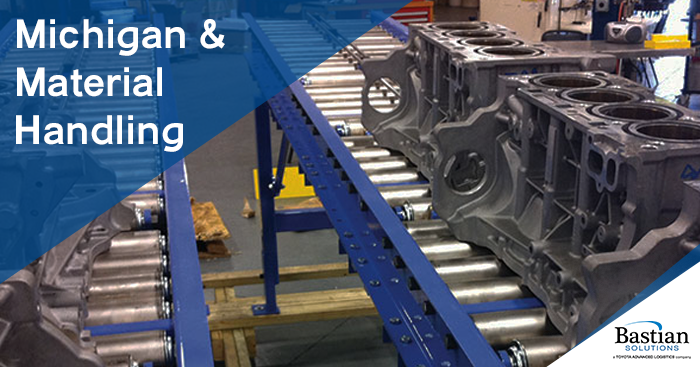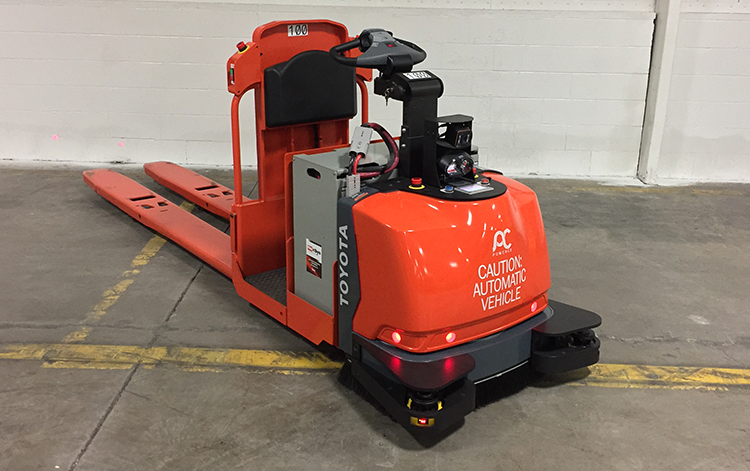
Michigan’s Contribution to Material Handling
David Musch | 23 May 2019
In 1795, the conveyor was invented to move food supplies onto ships. These early conveyors were hand powered leather running on wood planks. By 1804, conveyors were powered by steam engines. During the industrial revolution many advancements were made, including bearings and rollers to reduce friction and increase loads.
The Moving Assembly Line
Henry Ford saw conveyors in slaughter houses in 1913 and decided they would be a great help when assembling cars. His thought was to bring the cars to the workers instead of the workers moving their tools along with the cars. In today’s world, we call this goods-to-person. These conveyor lines were standard by 1919 in the automotive industry and the moving assembly line was invented.
When Ford took his moving assembly lines international by opening plants around the world, prospective competitors were forced to embrace his efficient process and copied the assembly line in order to compete. In America, this included General Motors and Chrysler, while Daimler and Volkswagen in Germany adopted the assembly line process to name a few.
Modern Manufacturing
Today, modern production lines resemble, in layout, the original line Ford developed. Assembling multiple parts together, in a line, on all sides simultaneously to complete the build as effectively as possible.
 Some of the same material handling design principles that Henry Ford developed are still in use by Bastian Solutions engineers today. Originally, conveyors revolutionized car production with efficiency. Today, new technologies like robots and automated guided vehicles (AGVs) are adding flexibility, reliability, and increased efficiency to the assembly process. Systems like AutoStore and Perfect Pick bring products to workers so they can assemble orders, similar to bringing chassis to a worker so they can install the engines.
Some of the same material handling design principles that Henry Ford developed are still in use by Bastian Solutions engineers today. Originally, conveyors revolutionized car production with efficiency. Today, new technologies like robots and automated guided vehicles (AGVs) are adding flexibility, reliability, and increased efficiency to the assembly process. Systems like AutoStore and Perfect Pick bring products to workers so they can assemble orders, similar to bringing chassis to a worker so they can install the engines.
Because accuracy is as important as speed, we utilize controls and scales to check weights, robots to build and install components, and conveyors and sorters to quickly and automatically move packages to the correct door for pick up.
Ford used to make a Model T every 93 minutes. Today Ford takes 25.7 hours per vehicle. Why the increase despite better technology? A Model T had only about 1500 parts vs. the average car today having around 20,000. Coordinating the assembly of 20,000 distinct pieces is a complicated dance of logistics and suppliers in order to have them all come together, at the assembly line, at one time.
Material Handling in Michigan
With three of the world’s top manufacturers in Detroit, many suppliers developing products to aid the assembly process are located in the region, including conveyor manufacturers, AGV manufacturers, and robot manufacturers.
Michigan’s history as a regional center of automotive manufacturing led to the rise of innovative assembly line technologies which have greatly increased efficiency and accuracy of material handling. We’re proud to be part of that legacy.
If you’re in search of material handling systems or manufacturing automation in Michigan, we’re happy to put our expertise to work for you. Contact us and we’ll work with you to find the best solutions for your operations and your budget.
I am a Regional Manager with Bastian Solutions, overseeing the Michigan and northern Ohio field offices. With over 25 years of experience in managing projects and selling conveyor systems, I enjoy closely working with our Field Application Engineers and Project Engineers and their varied customers.
Comments
No comments have been posted to this Blog Post
Leave a Reply
Your email address will not be published.
Comment
Thank you for your comment.